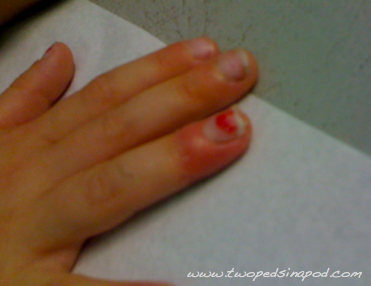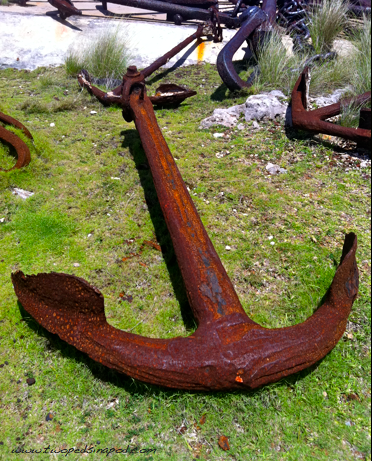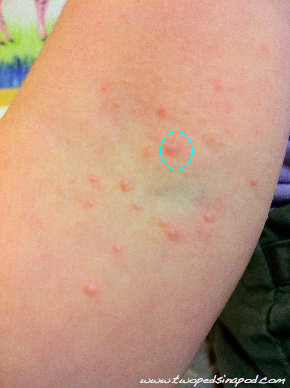It’s a nailbiter…paronychia infections

Ouch! This kid’s index finger has a finger nail infection called a paronychia. Often seen in nail biters and cuticle pickers, this infection occurs in the skin around fingernails. Although most kids are not dexterous enough to bite their toenails, infection can also occur in toes. Bacteria which normally live on skin (Staphylococcus or Streptococcus) find an opportunity to enter the body through openings in broken skin.
The area at the periphery of the nail bed is red, swollen, and painful. At times pus drains from under the nail bed.
Caught early, warm, soapy soaks several times a day may be enough to soften the tense skin and encourage germ-fighting cells to migrate to the infection. After soaking, apply topical antibiotic, such as Bacitracin, to the area. Often the infection improves after 2-3 days of diligent soaking.
Sometimes the infection persists and oral antibiotics are needed to treat the bacteria. In this photo, the redness of the child’s paronychia is spreading beyond the area immediately next to her nail. Besides increased redness, other worrisome signs of worsening infection include red streaks up the affected digit (a sign that the germs are trying to make it up to the heart), increasing pain, or fever. Your child’s pediatrician will make the call after examining your child.
Although I do not keep formal track, I do seem to see more of these infections at the start of the school year when kids at their desks begin to bite or pick their nails and cuticles. To prevent infection, remind your kids to wash their hands. If you have a biter/picker, have her substitute a different habit such as picking at a hair scrunchie or Silly Bandz. A more expensive and time consuming option, which Dr. Lai has seen work—offer a fancy manicure. Kids rarely want to ruin beautifully painted nails by chewing on them.
Julie Kardos, MD and Naline Lai, MD
©2012 Two Peds in a Pod®
 In the office it’s raining school forms. At this time of year, I see many of my patients embarking on their next stage of schooling. Kids I remember starting kindergarten are off to high school. Babies are starting daycare and teens are starting college. For all the parents who have a child entering a new school, whether it’s preschool or college, this letter is for you:
In the office it’s raining school forms. At this time of year, I see many of my patients embarking on their next stage of schooling. Kids I remember starting kindergarten are off to high school. Babies are starting daycare and teens are starting college. For all the parents who have a child entering a new school, whether it’s preschool or college, this letter is for you: My kids and I cheered as we watched the Olympic swim races together on TV. Having just finished their first summer swim team season, they were especially interested in these events. While we joked about how much faster Olympian swim times were than their own, we also noted that “just like on swim team” at the end of the races, the Olympians shook hands with the swimmers in the adjacent lanes. It got me thinking about sportsmanship.
My kids and I cheered as we watched the Olympic swim races together on TV. Having just finished their first summer swim team season, they were especially interested in these events. While we joked about how much faster Olympian swim times were than their own, we also noted that “just like on swim team” at the end of the races, the Olympians shook hands with the swimmers in the adjacent lanes. It got me thinking about sportsmanship. Although it’s called ringworm, this rash isn’t caused by a worm. In fact, it barely looks like a worm. Otherwise known as tinea corporis, the patch of ringworm is usually a flesh or light-pink colored, slightly scaly oval with raised, red edges.
Although it’s called ringworm, this rash isn’t caused by a worm. In fact, it barely looks like a worm. Otherwise known as tinea corporis, the patch of ringworm is usually a flesh or light-pink colored, slightly scaly oval with raised, red edges. 
 Two Peds in a Pod® turns
Two Peds in a Pod® turns  Vacation! As I watched my kids scamper across the beach today, I remembered a conversation I had with a family recently. “My kid sometimes coughs up sand,” the mom said to me. “Little hard specks sometimes come out of her mouth. ”
Vacation! As I watched my kids scamper across the beach today, I remembered a conversation I had with a family recently. “My kid sometimes coughs up sand,” the mom said to me. “Little hard specks sometimes come out of her mouth. ” 

